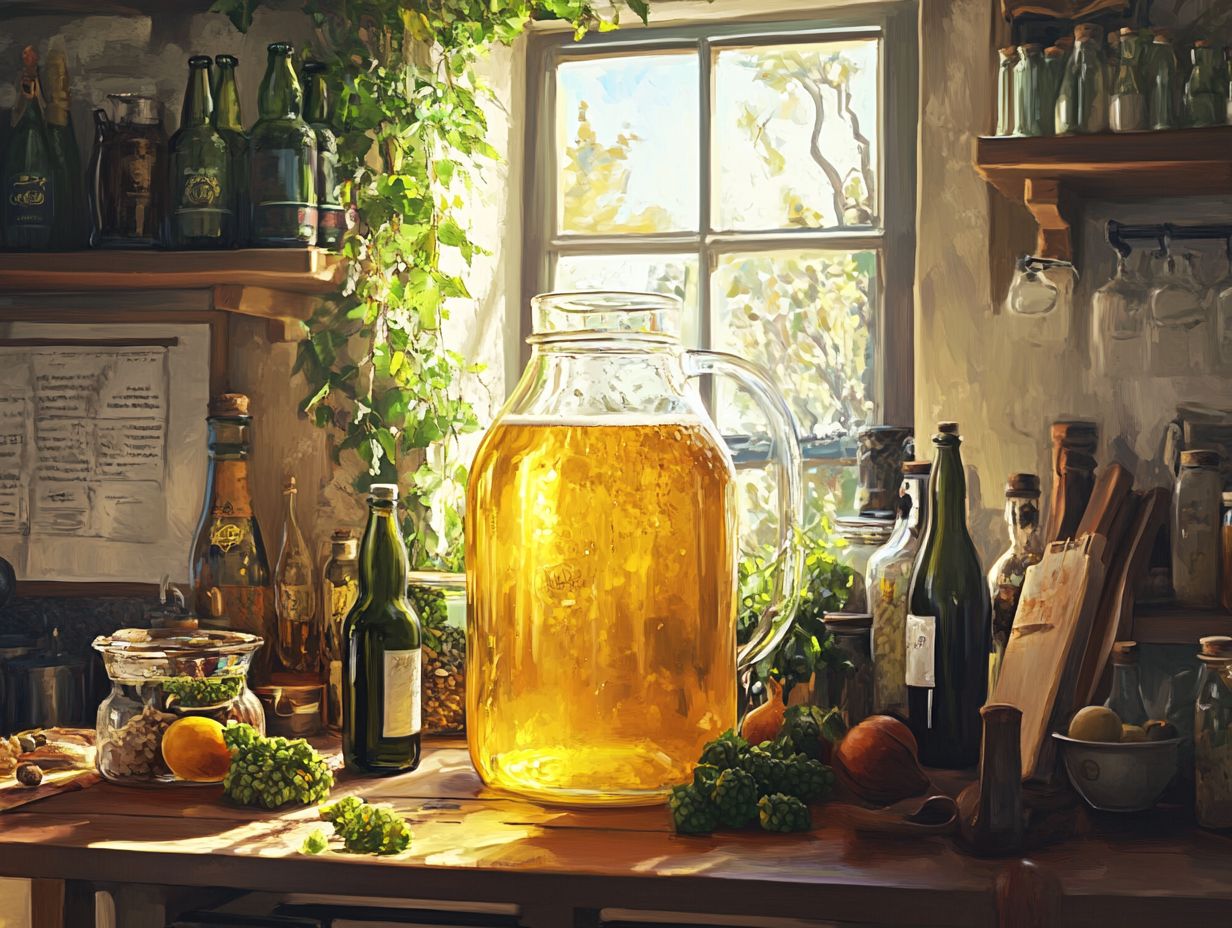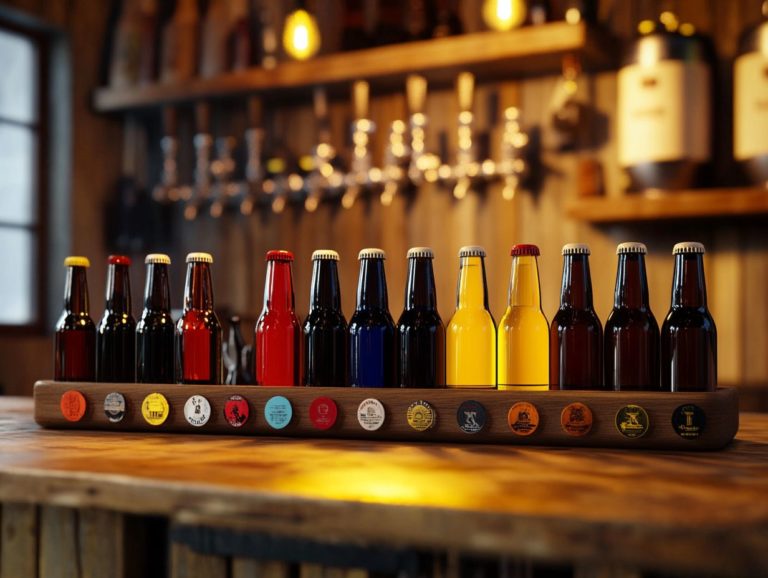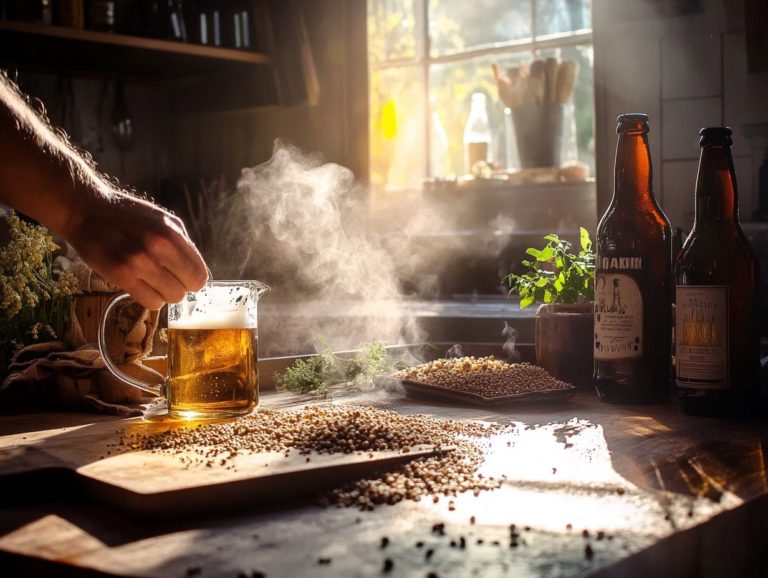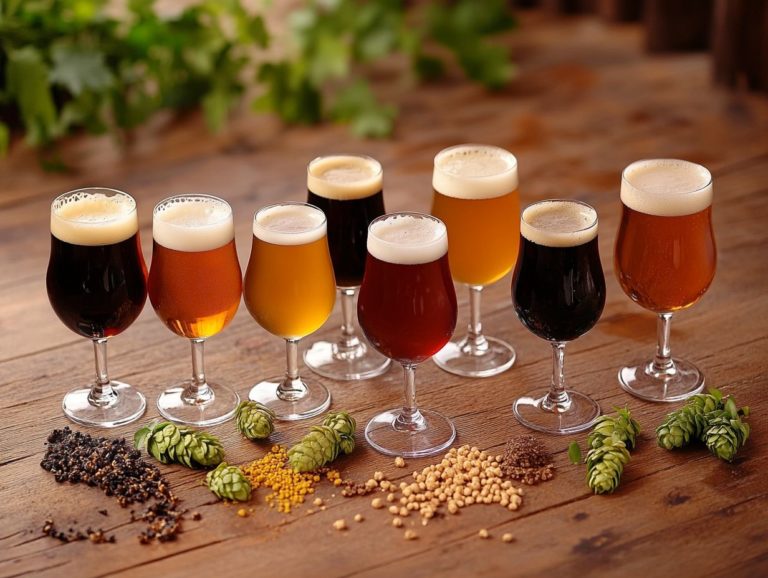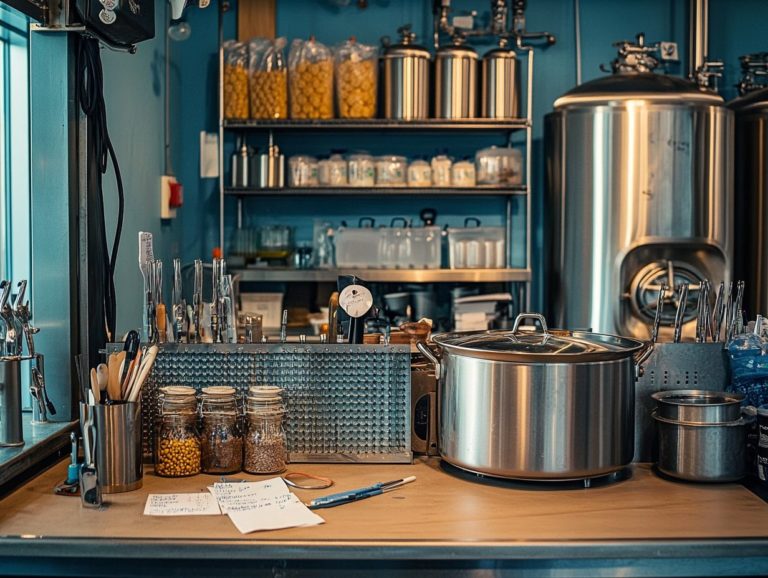How Do I Make a Sour Beer at Home?
Sour beer has become quite the sensation among craft beer aficionados, celebrated for its unique flavors and intricate brewing processes. The rise of sour ales, including styles like Berlinerweisse and Flanders, has caught the interest of many Americans.
This article delves into the captivating realm of sour beers, helping you grasp what they are and explore their diverse styles like Lambic, Berliner Weisse, and Gose. You’ll discover the key differences that distinguish them from traditional beers, enriching your understanding of these unique brews and the fermentation processes involved.
If you’ve ever contemplated crafting your own sour beer at home, you ll find a comprehensive guide here, detailing the essential steps, brewing tips, and ingredients you’ll need to create your own tantalizing concoction. From sour mashing to kettle souring, this guide has it all.
Dive into the exciting world of sour beer and unleash your creativity!
Contents
- Exciting Insights on Sour Beer:
- What Is Sour Beer?
- What Are The Different Types Of Sour Beers?
- What Makes Sour Beers Different From Other Beers?
- What Are The Steps To Make Sour Beer At Home?
- Frequently Asked Questions
- How Do I Make a Sour Beer at Home?
- What ingredients do I need to make a sour beer at home?
- How long does it take to make a sour beer at home?
- Can I use any type of beer to make a sour beer at home?
- Do I need any special equipment to make a sour beer at home?
- What are some tips for making a successful sour beer at home?
Exciting Insights on Sour Beer:
- Sour beer is a unique type of beer with a tart, acidic taste.
- There are various types of sour beers such as Lambic, Gueuze, Berliner Weisse, and Flanders Red Ale.
- To make a sour beer at home, you will need to choose the right ingredients, prepare equipment, mash grains, add souring agents, and age the beer.
What Is Sour Beer?
Sour beer represents a distinctive and flavorful realm within the craft beer landscape, one that has garnered significant appreciation among brewing enthusiasts, particularly within American brewing culture.
Many homebrew shops have even started to stock specific ingredients for those interested in creating sour beers.
These unique brews are characterized by the intentional creation of lactic acid through various fermentation processes. They often harness wild yeast strains like Lactobacillus and Pediococcus, as well as Acetobacter for additional complexity.
Sour beers are crafted using traditional methods that highlight sour mashing and kettle souring techniques. This leads to an impressive array of flavor profiles that challenge the conventional understanding of what beer can be.
What Are The Different Types Of Sour Beers?
The world of sour beer invites you into a fascinating realm of styles, each one revealing its own unique traits shaped by specific fermentation processes and carefully selected ingredients, which can include everything from black rice to Rakau hops.
You ll find Berlinerweisse, a German wheat beer celebrated for its delightful tartness, standing out among the most cherished varieties.
Then there are the Lambics, which encompass traditional Belgian styles like Gueuze and Flanders Red Ale. Each offers its own rich storytelling. Notable examples include Cantillon Classic Gueuze and Russian River Beatification.
Don t overlook the rise of American Wild Ales, as they take the stage with bold experimentation using local ingredients and wild yeast. They craft innovative flavor profiles that truly reflect the brewer’s personal artistry.
1. Lambic
Lambics are a treasure of traditional Belgian sour beers, distinguished by their spontaneous fermentation process. They harness the wild yeast and bacteria that linger in the environment, resulting in complex and intriguing flavor profiles.
This remarkable brewing method is profoundly shaped by the unique conditions of the Brussels region. The beers are exposed to the wild yeasts that float through the air. This exposure imparts a character that simply cannot be duplicated anywhere else, much like how city water can influence the taste of beer.
Among the various styles of Lambics, Gueuze captures attention with its delightful blend of younger and older Lambics, yielding a sparkling and refreshing drink.
On the other hand, Fruit Lambics are crafted with local fruits like cherries or raspberries, showcasing vibrant flavors that dance on the palate. The alcohol content of these beers can vary widely, adding another dimension to your tasting experience.
Noteworthy examples, such as Cantillon, have significantly influenced the craft beer landscape, inspiring brewers worldwide to delve into the captivating world of sour beer-making.
2. Gueuze
Gueuze is a distinctive Belgian sour beer appreciated for its unique production process. It involves blending young and old Lambics, which are then bottle-conditioned to develop a sparkling effervescence and a complex flavor profile that is simply unparalleled.
This method sets Gueuze apart from other sour styles. Unlike them, Gueuze utilizes blending and the extensive aging process that demands careful measurements of young to old Lambics, creating a harmonious balance of fruity, tart, and earthy notes that define this exceptional style.
The aging requirements for Gueuze are quite strict. The younger Lambic must be at least one year old, while the older Lambic needs a minimum of three years to truly cultivate those rich, layered flavors. Notable producers like Brouwerij Boon and Brouwerij 3 Fonteinen exemplify this craftsmanship, delivering a product that beautifully reflects the deep-rooted Belgian brewing tradition.
For craft beer aficionados like yourself, Gueuze offers an intriguing journey of taste and texture. Each bottle presents a unique experience, inviting you to savor the complexity and richness that only Gueuze can provide. Don t miss out on the chance to explore this extraordinary beer!
3. Berliner Weisse
Berliner Weisse is a German-style sour beer that offers a delightful experience light, refreshing, and delightfully tart. It makes for an ideal companion on those warm, sunny days.
The fermentation process behind this exquisite brew is an artful dance of yeast and bacteria, typically harnessing Lactobacillus to create that signature sour flavor. This careful method elevates its refreshment factor and adds complexity that appeals to both newcomers and seasoned connoisseurs. Fast sour techniques are sometimes used to reduce the time typically required.
Often, you ll find it served with a splash of flavored syrup. Think raspberry or woodruff transforming the beer into a customizable delight that caters to various tastes.
With roots tracing back to the 16th century, Berliner Weisse holds a cherished place in Germany s brewing heritage. It proudly sits within the expansive world of sour beers, which have surged in popularity, thanks to their quirky finishes and vibrant flavor profiles.
4. Flanders Red Ale
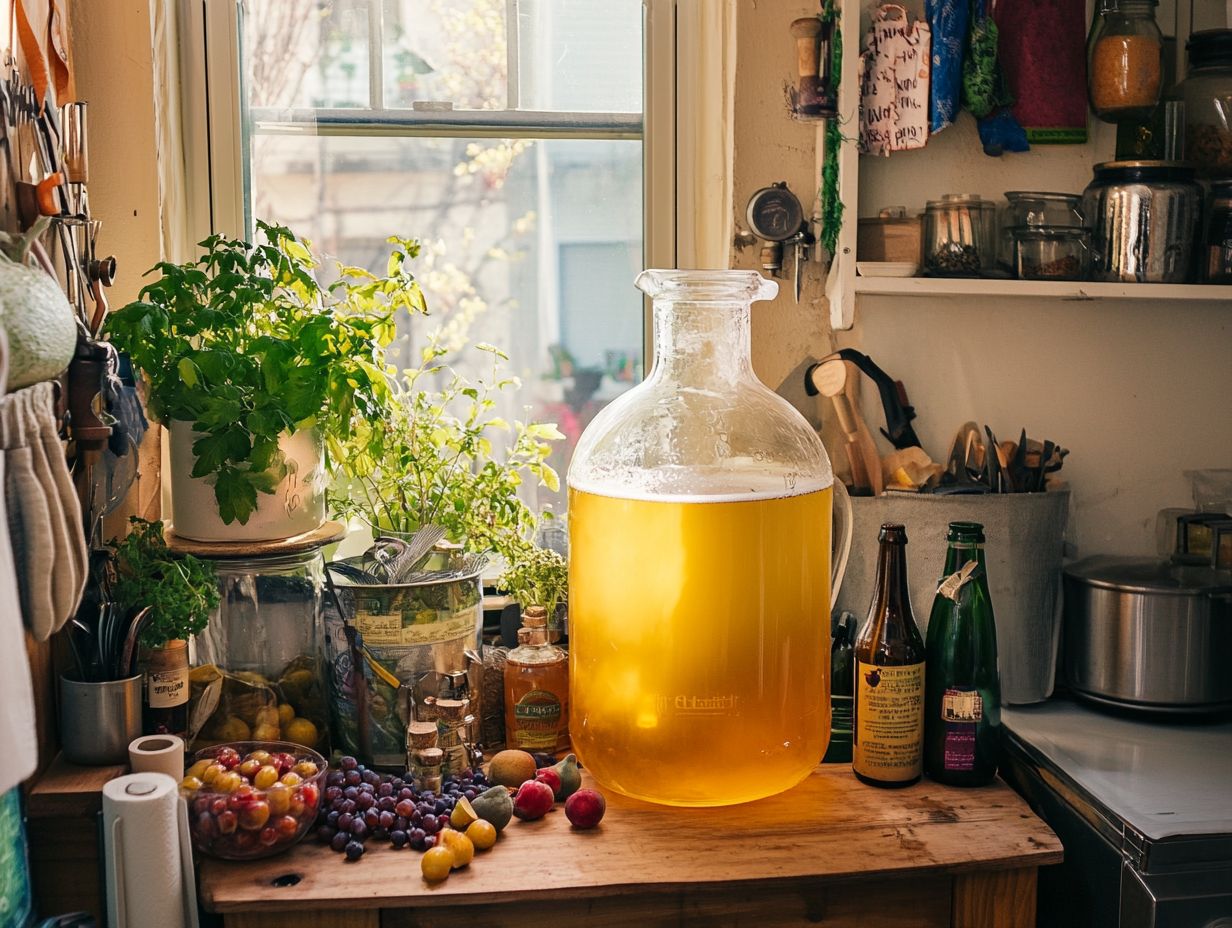
Flanders Red Ale is a traditional Belgian sour beer that beckons you with its rich, malty character, perfectly intertwined with tart notes. Typically aged in oak barrels, this aging process is crucial in crafting its unique flavor.
The interaction between the beer and the wood introduces lactic acid bacteria and wild yeasts, such as Saflager yeast, lending complex sourness and depth. As time passes, the beer undergoes a remarkable transformation, revealing layers of fruitiness, vinegar-like acidity, and subtle woody nuances.
Notable examples like Duchesse De Bourgogne and Rodenbach Grand Cru showcase this intricate craft. They embody the centuries-old Belgian brewing tradition where careful attention to detail and patience culminate in a harmonious blend of flavors. This experience appeals to both novice and seasoned drinkers alike, inviting you to savor every sip.
5. American Wild Ale
American Wild Ales represent a captivating category of sour beers that invites you to dive into a world of experimentation and creativity. They often utilize a variety of wild yeast strains and locally sourced ingredients, allowing for an extraordinary range of flavors.
This unique approach enables brewers to blend traditional brewing methods with innovative practices that capture the essence of their surroundings. You ll find that these ales incorporate not only distinctive hops but also fruits, spices, and even herbs sourced from local farms, leading to an authentic, localized flavor experience.
The community of brewers, particularly groups like Milk the Funk, plays a vital role in promoting this dynamic style. They foster collaboration and the sharing of knowledge among enthusiasts. As a result, American Wild Ales challenge conventional notions of beer, inviting you to savor the rich tapestry of flavors that each sip has to offer. This is especially true in American brewing, where innovation and creativity are highly valued.
What Makes Sour Beers Different From Other Beers?
Sour beers set themselves apart from traditional beer styles largely due to their distinctive fermentation processes, which often introduce lactic acid and create flavor profiles that defy conventional taste expectations.
Unlike standard ales and lagers that typically rely on specific yeast strains for fermentation, sour beers embrace a medley of bacteria and wild yeast that lend them their signature tartness and complexity.
This departure from traditional brewing methods enables sour beers to present an array of unique flavors. This makes them an intriguing category within the craft beer community that invites exploration and appreciation.
What Are The Steps To Make Sour Beer At Home?
Crafting sour beer at home can be an immensely rewarding venture. It demands careful attention to detail, specific brewing equipment, and a nuanced understanding of the fermentation process.
Whether you’re using wild yeast or specific strains like Lactobacillus (a type of bacteria) and Pediococcus (another type of bacteria), each choice impacts the final product.
It all starts with sourcing the right ingredients from homebrew shops, setting the foundation for your brewing journey. Selecting the ideal components and equipment is crucial. Each step from mashing to bottling must be executed with precision to cultivate the desired sourness and complexity in your beer.
Armed with effective brewing tips and techniques from brewing experts, you have the opportunity to create distinctive flavors. These truly embody your personal style and preferences.
1. Choose The Right Ingredients
Selecting the right ingredients is absolutely essential for brewing sour beer. Your choices in malt, hops, and yeast will dramatically shape the final flavor profile and acidity.
Malt serves as the backbone of the beer s body. It not only contributes sweetness and color but also complements the sour elements, resulting in a beautifully balanced experience.
Hops, while typically used sparingly in sour brews, still add a layer of complexity and aroma that elevates the overall profile.
The choice of yeast is particularly crucial. Strains like Lactobacillus and Pediococcus are favored for their remarkable ability to produce lactic acid, intensifying the beer’s delightful tartness.
Introducing wild yeast can unlock an entirely new dimension of character. This paves the way for unpredictable and thrilling flavor developments.
Every decision you make regarding ingredients sends ripples through the brewing process. It influences everything from aroma to mouthfeel, ultimately defining the unique signature of your sour beer.
2. Prepare The Equipment
Preparing your brewing equipment is a vital step in crafting exceptional sour beer. Proper sanitation is crucial. It prevents unwanted bacteria from disrupting the fermentation process.
To achieve that intricate balance of flavors that sour brews are known for, you need to invest in high-quality equipment. This includes fermentation tanks, temperature control systems, and specialized souring vessels.
Each piece of equipment requires meticulous sanitation before use. Neglecting this step significantly increases the risk of contamination.
It s not just the brewing vessels that need attention; any tools that will come into contact with the wort should be thoroughly cleaned as well.
Using a solution of hot water and a reputable sanitizer will effectively eliminate any lingering microorganisms.
By maintaining a clean workspace throughout the brewing process, you minimize the risk of cross-contamination. This diligence helps ensure that the desired sourness and flavor profile develop without interference from any undesirable elements.
Introduction
Brewing sour beer is an exciting journey filled with unique flavors and techniques. The following steps will guide you through the essential phases of the brewing process, ensuring you achieve a deliciously tangy brew.
3. Mash The Grains
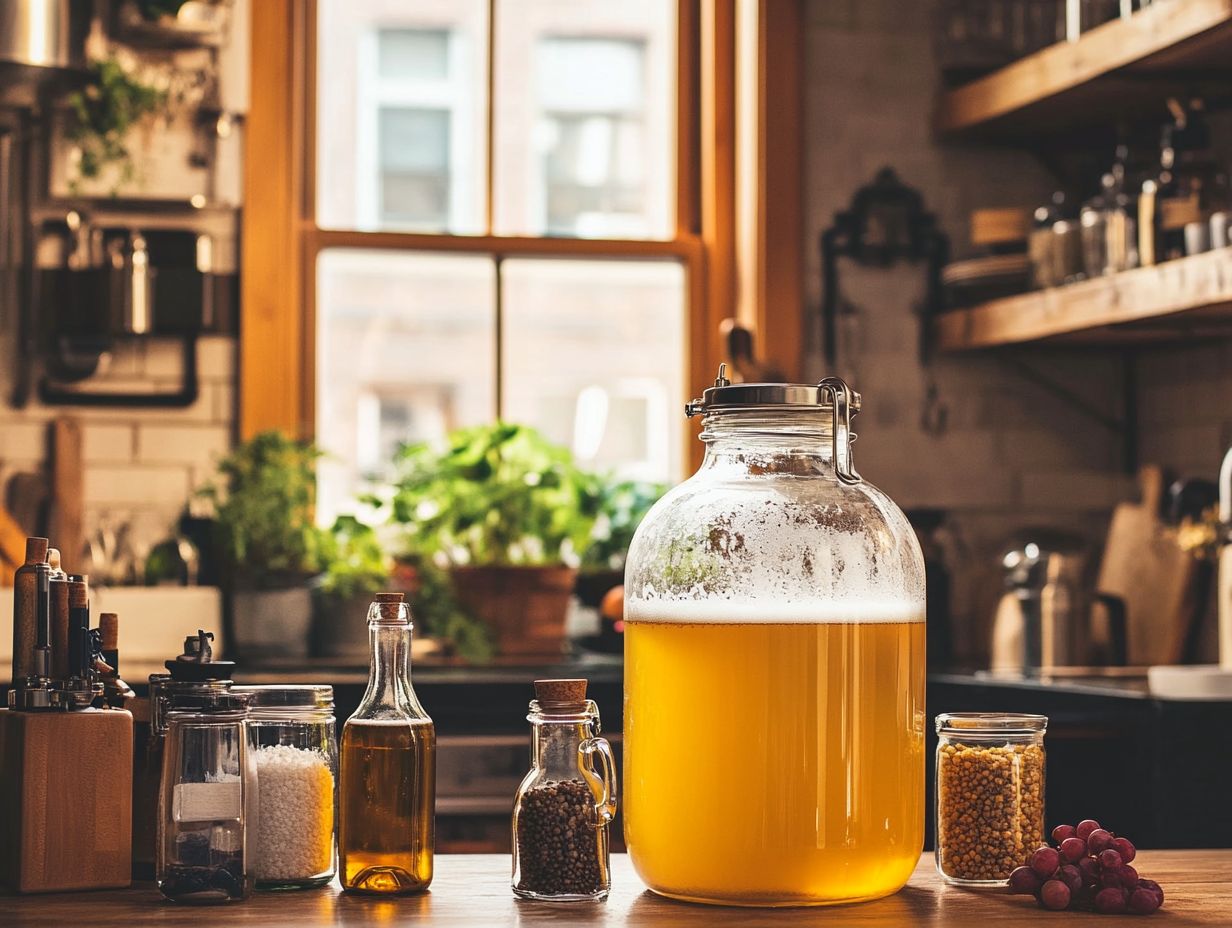
Mashing the grains is an essential step in brewing sour beer. This process enables enzymes to transform starches into fermentable sugars, which are crucial for fermentation.
This process typically unfolds at temperatures between 140 F and 158 F. Here, enzyme activity is maximized for optimal sugar extraction. Timing is essential during mashing; a duration of 60 to 90 minutes is generally advised to ensure complete conversion. The specific temperature and duration impact sugar extraction efficiency and significantly influence the beer s final flavor profile. Higher temperatures can create a sweeter, thicker mouthfeel, while lower ones may yield a drier finish.
To elevate this step, closely monitor the temperature. Consider using step mashing altering the temperature at designated intervals. This technique can unlock complexity and depth of flavors, allowing various enzymes to interact with the grains at different stages of mashing.
4. Boil The Wort
Boiling the wort is a vital step in your brewing journey. This is where you introduce hops to impart bitterness and aroma while ensuring the liquid is sterilized.
This crucial phase banishes unwanted microbes and significantly influences your beer’s final flavor profile. During boiling, you’ll extract essential oils from the hops, which play an important role in shaping aroma and taste. In sour beer, hops take on a distinctive role; they may not steal the spotlight but expertly balance acidity and add layers of complexity.
When selecting hops, consider their alpha acid content and the timing of their addition. Early additions provide the necessary bitterness, while late or dry hopping can infuse delightful aromas. By incorporating different hop varieties at various stages, you can elevate the overall experience. Thus, it is essential to experiment with intention and creativity.
5. Cool The Wort And Add Yeast
Cooling the wort is a crucial step that must be executed swiftly to prevent contamination and prepare for the important addition of yeast, which is vital for fermentation.
This rapid cooling process, typically accomplished with methods like immersion chillers or counterflow chillers, brings the wort down to a temperature that s just right for yeast activity while simultaneously stunting the growth of unwanted bacteria. Act fast when brewing sour beers! Bacteria can quickly spoil your batch if you aren’t careful.
After cooling the wort, your choice of yeast becomes paramount. Different strains impart their unique flavors and aromas to the final product. For example, some yeasts amplify fruity notes, while others may evoke earthy tones, effectively influencing the overall character of your sour beer.
6. Let It Ferment
Fermentation stands as the most critical stage in producing sour beer, where the magic happens. Yeast and bacteria, such as Lactobacillus and Pediococcus, change sugars into alcohol while generating lactic acid.
This intricate process can span from just a few days to several months, depending on the level of sourness you aim to achieve and the specific techniques you choose. Ideal conditions typically involve maintaining temperatures between 60 F and 80 F, fostering vigorous activity of these microorganisms.
By adjusting elements like fermentation time or temperature, or even introducing fruit or other fermentables, you can significantly shape the final flavor profile. For instance, a longer fermentation may yield a more complex tartness. Moreover, selecting specific yeast strains can infuse fruity or funky notes, crafting a unique taste experience that tantalizes the palate.
Now that you have learned the brewing process, why not try brewing your own sour beer? Share your results and join the exciting community of home brewers!
7. Add Souring Agents
Incorporating souring agents like Lactobacillus or Pediococcus during or after fermentation is key to achieving the tartness and complexity you seek in sour beer.
Timing is everything when it comes to introducing these souring agents; it can profoundly impact the beer’s overall flavor profile. Adding them during fermentation allows these microbes to integrate more seamlessly into the brew, enabling flavors to meld beautifully over time. On the other hand, introducing them post-fermentation delivers a sharper, more pronounced sourness.
Each approach offers its own unique characteristics, and experimenting with different strains can yield a surprisingly diverse array of flavors. You’ll discover that variations in temperature, time, and the specific strains used can lead to distinct profiles, fostering a sense of creativity and individuality in every batch you craft.
8. Age The Beer
Aging sour beer is an exciting phase that transforms your brew, unlocking complex flavors as it interacts with wood barrels or containers, enhancing its overall flavor profile.
This interaction is greatly influenced by the type of wood you choose; for instance, oak can impart delightful notes of vanilla and spice, while cherrywood may introduce subtle fruity undertones. The aging process also allows the wild yeast and bacteria present to work their magic, creating unique characteristics that deepen the complexity of both aroma and taste.
For optimal results, certain sour beers, particularly those brewed in a traditional Flanders style, can benefit from aging for one to three years. Meanwhile, lambics can often be left to mature for much longer, sometimes exceeding five years. On the other hand, Berliner Weisse styles are best enjoyed at a younger age, typically within a few months, to preserve their refreshing, tart qualities.
Each style has its own aging requirements, ultimately leading to the perfect balance of flavor when given the time it deserves.
9. Bottle Or Keg The Beer
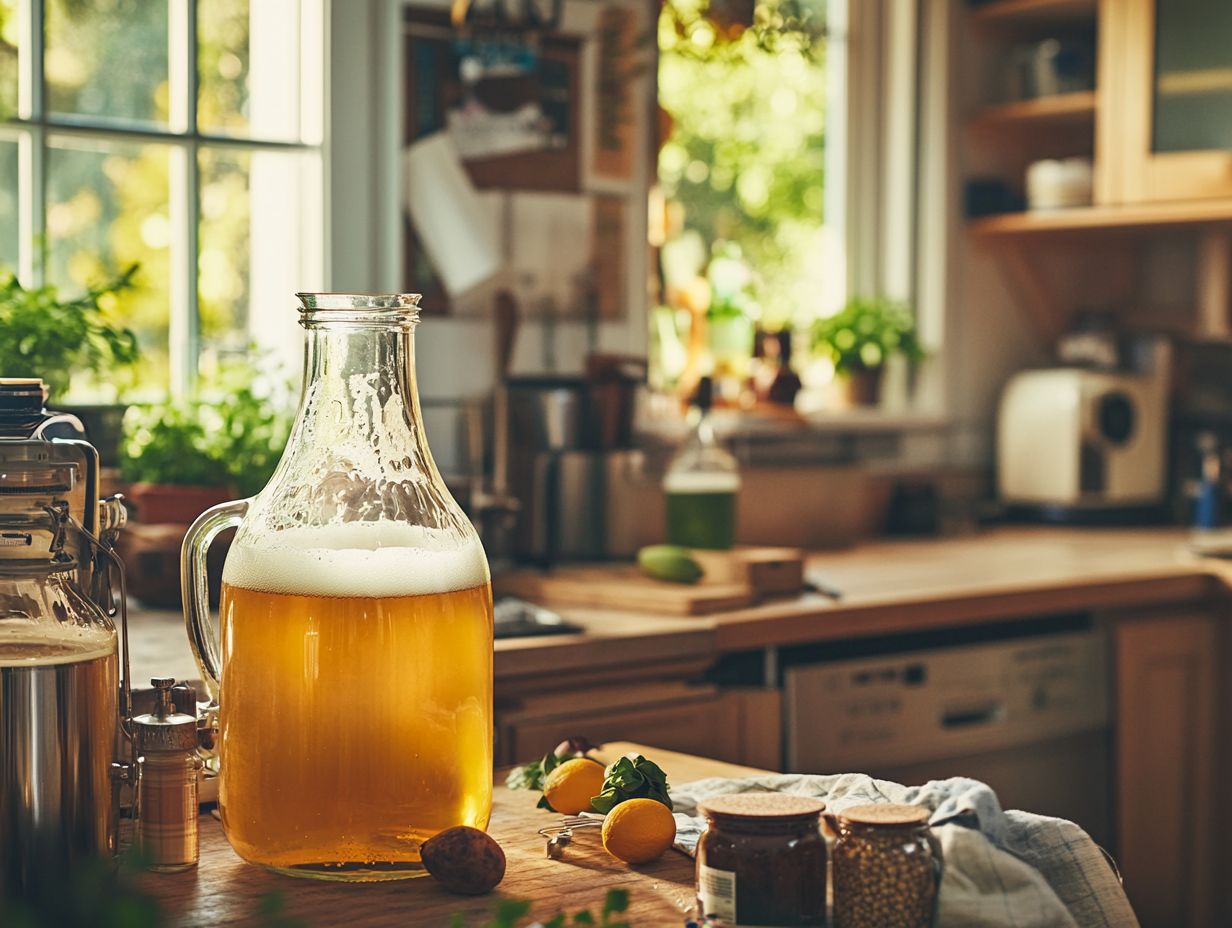
Bottling or kegging sour beer marks the final step in the brewing journey, where carbonation comes to life and the beer is primed for enjoyment. This crucial phase demands your understanding of the unique advantages and challenges presented by each method.
For example, when you opt for bottling, you typically add priming sugar, which is a small amount of sugar that sparks carbonation during conditioning. Kegging offers a more controlled carbonation process with a CO2 tank, allowing for precision in achieving your desired fizziness. Each technique not only impacts the final flavor and mouthfeel of the beer but also plays a significant role in storage and transport considerations.
To ensure your beer’s quality and safety, maintaining impeccable cleanliness of your equipment is essential. Employing proper sealing techniques will help prevent any contamination that could jeopardize your brew. Keeping a close eye on the fermentation process is vital for preserving the desired sour profile, making these factors critical for crafting a high-quality product.
Frequently Asked Questions
How Do I Make a Sour Beer at Home?
To make a sour beer at home, such as Berlinerweisse or Gose, you will need to follow a specific brewing process using ingredients that will create the desired sour flavor and unique flavors.
What ingredients do I need to make a sour beer at home?
The main ingredients for making a sour beer at home include malted barley, hops, and yeast, as well as bacteria cultures such as Lactobacillus, Pediococcus, and Acetobacter. You can also use wild yeast for more complex flavor profiles. For water, city water is often sufficient, but ensure it’s free from chlorine or chloramine.
Now that you know how to make sour beer at home, gather your ingredients and start brewing! Share your experiences and creations with fellow brewing enthusiasts.
How long does it take to make a sour beer at home?
The process of making a sour beer at home can take anywhere from a few weeks to several months, depending on the specific recipe and method used, such as kettle souring, sour mashing, or traditional methods. This investment of time is crucial for achieving the desired lactic acid levels and overall flavor profile.
Can I use any type of beer to make a sour beer at home?
Excitingly, you can use almost any beer to create your sour masterpiece! While some beer styles, like Lambics and Flanders, are better suited for souring, it is recommended to start with a simpler recipe if you are new to brewing sour beers. Consider trying a basic sour ale or a fast sour technique.
Do I need any special equipment to make a sour beer at home?
Yes, you will need specific brewing equipment, such as a fermentation vessel (a container where the beer sits to develop flavor), an airlock, and a siphon. It is also wise to have a separate set of equipment specifically for sour beers to avoid cross-contamination. Homebrew shops offer these items and valuable brewing tips.
What are some tips for making a successful sour beer at home?
Some tips for making a successful sour beer at home include:
- Maintaining a clean and sanitary brewing environment.
- Using quality ingredients.
- Being patient during the brewing and fermentation process.
Research and follow a tried-and-true recipe to increase your chances of success. Familiarize yourself with brewing culture by exploring resources like Milk the Funk and learning from the American brewing community.
Consider experimenting with different ingredients such as Rakau hops, Saflager yeast, or even black rice to create unique flavors. For inspiration, you might explore famous sour beers like Cantillon Classic Gueuze or Russian River Beatification.
Start brewing today to create your unique sour beer!

